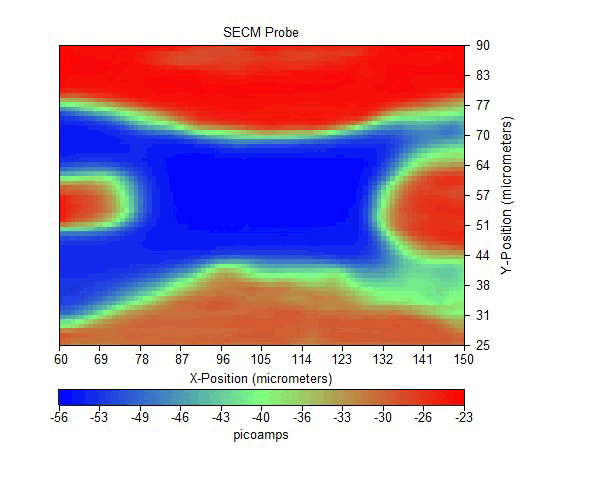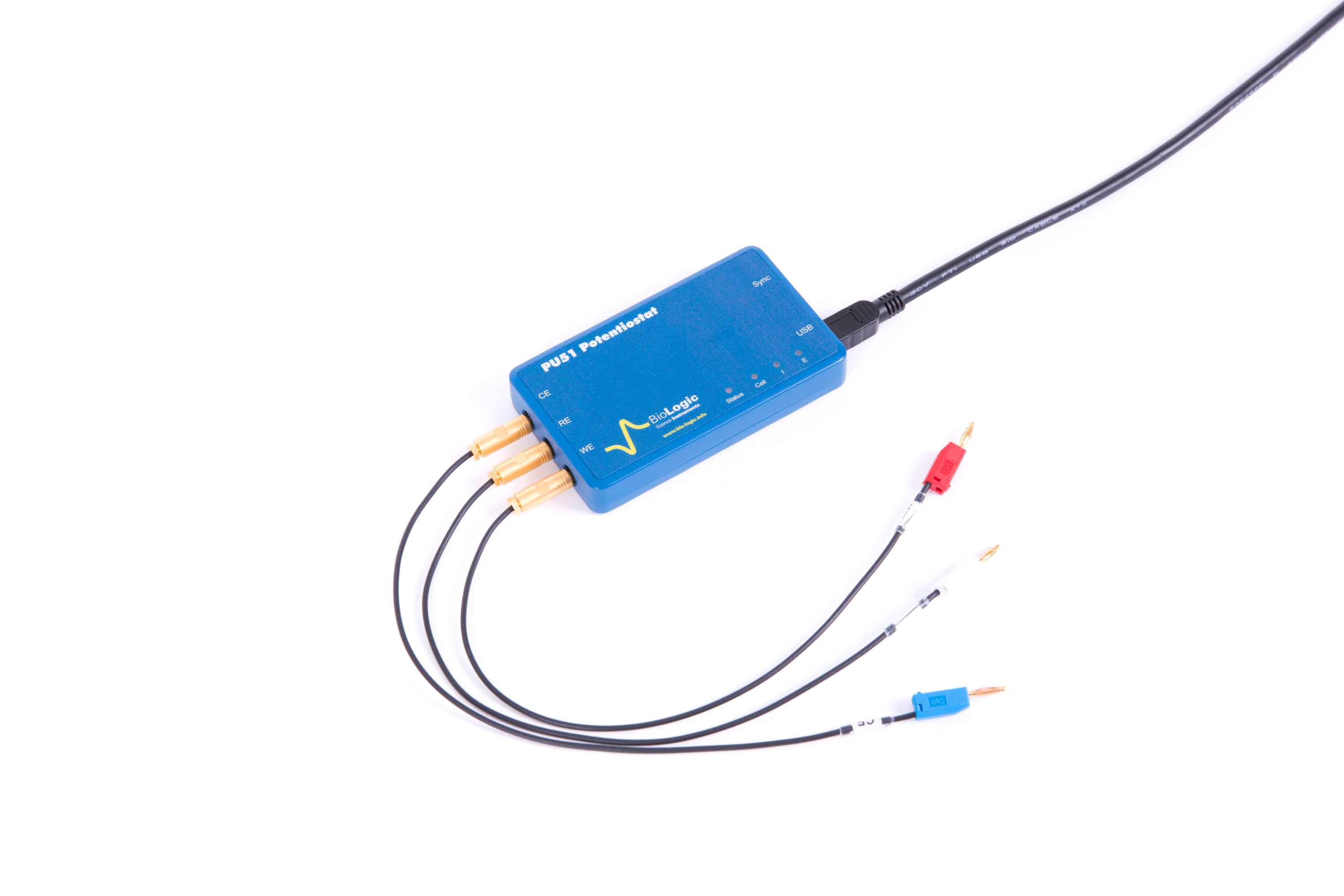SECM150.
Powerful Electrochemistry workstation for measuring the local activity of samples
Compact SECM built for high-resolution imaging, x,y stages are fully separated from z stage to reduce crosstalk
A powerful Electrochemistry workstation used for measuring the local activity of samples
Scanning ElectroChemical Microscopy (SECM) is a Scanning Probe Microscopy (SPM) technique, which measures the local activity of a sample. Unlike other SPM techniques the local activity of SECM shows chemical selectivity due to its use of a redox mediator. SECM is the most popular Scanning Probe Electrochemistry technique. As with other techniques in this family SECM it can be used to gain further insight into the electrochemistry occurring at the bulk level. SECM differs from other Scanning Probe Electrochemistry techniques because it does not have an activity requirement. As a result, SECM can measure anything from a fully insulating to a fully conducting sample, making it applicable to a wide range of systems.
The SECM150 represents a new standard for fundamental SECM. It has been designed for constant height dc-SECM measurements. All of its components from the PU51 potentiostats to the scanning stage have been optimized for these measurements. Therefore the SECM150 is capable of achieving high-resolution measurements, even of dynamic samples.
Anything of interest electrochemically is a potential candidate for SECM measurements. The high resolution of the SECM150 makes it ideal for the measurement of biological samples. This is particularly the case when the biological system under study is dynamic. Relatively flat samples are well-suited to measurement by the SECM150, including those in fields such as batteries and materials. It is also the perfect candidate when performing kinetics studies which require the probe approach curves, followed by cyclic voltammetry at the sample surface.

Overview: A compact SECM built for high-resolution imaging
- Small footprint
- x, y stage separate from z stage to reduce interactions
- Fast enough for dynamic samples
Compact
The SECM150 is the smallest SECM available from Bio-Logic. The scanning stage has a footprint of only 22.5 cm x 35.5 cm. This is all achieved without compromising on instrument performance. The compact size of the SECM150 makes it ideal for laboratories with limited space. Furthermore, its compact size makes it perfect for use in gloveboxes, fumehoods, and Faraday cages.
Scanning optimized for high-resolution SECM
The scanning stage of the SECM150 has been designed specifically for high-resolution SECM measurements. Fine positioning for all three axes is performed using piezo scanning stages. These piezo stages are used in all SECM experiment types, including probe approach curves, and area scans. By using piezo positioning the SECM150 can achieve a positioning resolution better than 10 nm to achieve high-resolution images. These measurements can be achieved without artifacts from the scanning stage. The z-axis is mounted separately to the x,y scanning stage. This separation avoids detrimental crosstalk between the axes during scanning. The coarse movement of the system is achieved with lockable micrometers. After coarse positioning, the micrometers can be locked in place to avoid drift in the system, which can otherwise distort high-resolution measurements. Finally, scanning can be performed at a rate of up to 20 points/s. This scan rate allows measurements of even changing samples to be performed.

Experiment design through sequencing
The ability to perform non-standard experiments is important in some applications. Through the SECM150 software, users have the ability to design their own experiments through the sequencing tool. This tool allows users to sequence and run all experiment types available including chronoamperometry, cyclic voltammetry, line scans, and area scans. At the completion of each experiment the software will automatically save the data before moving to the next step. Experiments can even be sequenced with logic steps in between allowing for probe movements, delays, and looping of experimental sequences.
SECM150 Software
The SECM150 software provides unique capabilities and interactivity in support of the SECM150 nanometer-resolution scanning electrochemical microscope. This user-friendly software includes a wide range of powerful features including:
- Manipulate, enhance and analyze data. and interactivity.
- Facilitate research with automated measurements and sequencing.
Seven discrete experiments provided throughout, each with their own individual variations such as:
- Step Scan
- Pre-Delays, Line-Delays, Velocities, Step Sizes, Scan Dimensions, Signal Conditioning Parameters, Control Loop Parameters, Potentiostat Setting etc.
The Software provides 64bit WindowsTM support in a standard Multiple Document Interface (MDI) application that supports all standard WindowsTM features.
| Scanning Stage | |
| Scan Range | x & y: 200 µm |
| z: 100 µm | |
| Minimum Step Size (x,y,z) | 50 nm |
| Positioning | Fine positioning is performed by piezo on all three axes. |
| Macro positioning is performed over a 13 mm range with manual micrometers. These can be locked during experiments. | |
| Max Scan Speed | 200 µm/s |
| 20 points/s | |
| Measurement Resolution | < 10 nm resolution |
| Dimensions | 180 mm (H) x 225 mm (W) x 355 mm (L) |
| PU51 | |
| Compliance Voltage | ±5 V |
| Applied Potential | ±2.048 V |
| Resolution | 62 µV |
| Measured Potential | ±2.56 V |
| Resolution | 78 µV |
| Current Ranges | 100 pA to 1 mA |
| Maximum Current | ±2 mA |
| Current Resolution | 0.5% range for 1 nA and above |
| 2% for 100 pA | |
| Cell Connections | 2, 3, or 4 electrode |
| Modes | Potentiostat, OCP |
| Available Experiments | Chronoamperometry, Cyclic Voltammetry, Linear Voltammetry, Chrono OCP |
| General | |
| Available Probes | Options from 1 µm to 25 µm |
| Control Box Dimensions | 85 mm (H) x 235 mm (W) x 180 mm (D) |
| Operating Temperature Range | 25 °C ±5 °C |
| Operating Humidity Range | < 55 % |
| Power | 100 to 240 V, 50/60 Hz, 60 W (Universal external certified power pack) |
| PC Connection | USB |
| Available SECM Experiments | Approach Curve Experiment, Line Scan Experiment, Area Scan Experiment |
Is there any analysis software available for use with the SECM150?
The following documents relate to analysis software for the SECM150:
- AN#5 – Introducing the Microscopic Image Rapid Analysis (MIRA) software
- AN#12 – 3D Map production using the 3DIsoPlot software
What application areas can I use the SECM150 for?
- AN#19: Investigation of the diffusion of ferricyanide through porous membranes using the SECM150
- AN#21: Using the SECM150 to Measure an NMC Battery Electrode
- SECM for Biosensors
- Application of local electrochemical probes for coatings studies
- Application of local electrochemical probes for energy studies
- Application of scanning probe electrochemistry for biological studies
I see you supply 1 µm probes. Can I use these with the SECM150?
Greater Scope. Increased flexibility.
The following equipment may help you go further with your research.